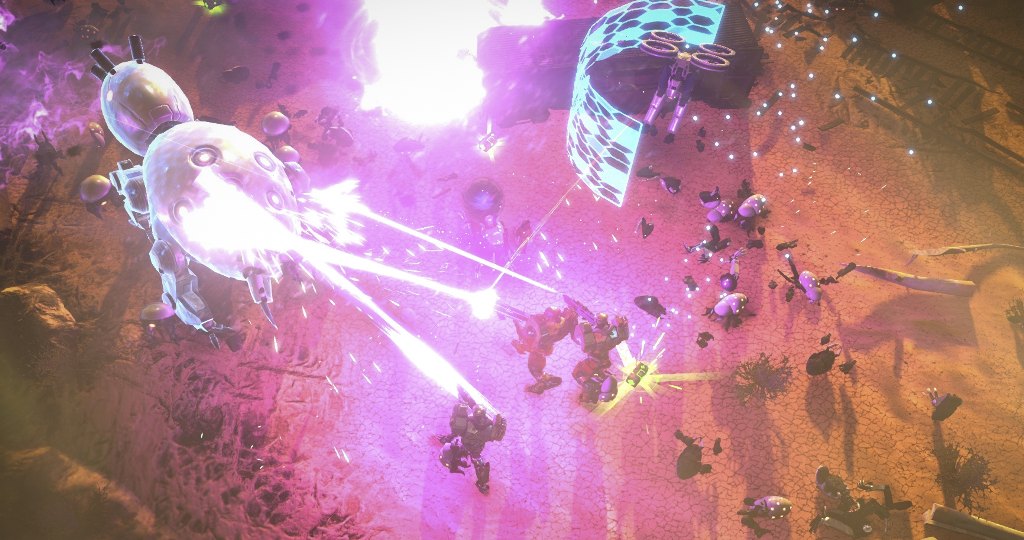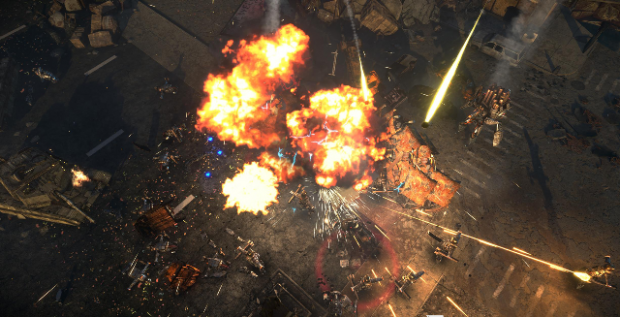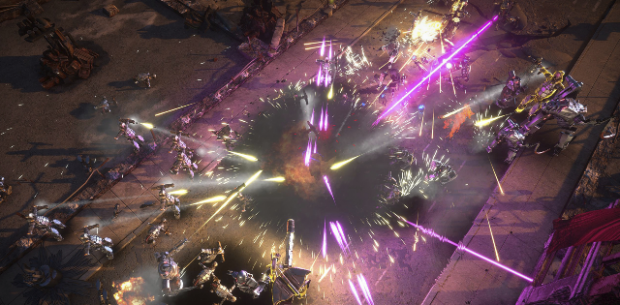Nearly as reliable as death or taxes, they’ve come once again. As we sit here just days from the official start of another E3, the article after article after article about the questionable value proposition of the games industry’s annual showcase tradeshow in LA have appeared. The (somehow) simultaneous increasing diversification and conservatism of the industry combined with digital distribution are two of the biggest reasons E3’s future is yet again being called into question. Another is the proliferation of other industry events, such as four annual Penny Arcade Expos.
And while no one seems to know just what the hell E3 is for or about anymore, at least one developer found explicit purpose in March’s PAX East in Boston. For Tuque Games, it was their first opportunity to show the world twin-stick shooter Livelock. The Montreal studio sent nearly half of its 22 developers across the border to see if the public would play its game the way it intended; to find out if there was anything Tuque needed to fix or improve during the homestretch of development; and, most importantly, if anybody liked the damn thing. According to Tuque Lead Game Designer Kevin Neibert, the studio accomplished all three goals.
On a call earlier this week, Neibert admitted that the team had some minor jitters going in, but the experience was extremely positive — and helpful. “The feedback that we got from people playing the game was incredible,” he said. “Between the three days we had 1,200 people play, which is insane. The biggest playtest we’ve had before was maybe 10 people, which was people who were friends of friends, so to see people who never actually played the game before getting first impressions, it was an incredible experience for us.”
Neibert said most of the feedback was related to issues already on the team’s radar, but all those new players did pick up on a few things Tuque hadn’t previously seen as problems. One of the problems sounds like a classic case of not being able to see the forest for the trees.
“In Livelock, your character is surrounded by between 20 and 40 different enemies, all the enemies have different attacks, there’s special effects everywhere, everything is exploding,” explained Neibert. “As developers we play the game a lot, and we kind of get in the flow, and we’re able to identify the enemies much more readily than someone who is having their first experience with it.
“So one of the major [pieces of feedback] that I think we learned a lot from was new players having a hard time identifying where their character is on the screen just because of all the chaos that’s going on around you. We definitely took note of that and we made a bunch of strides recently in improving the clearness and the positioning of the player. So now we have a disc under each character that’s aligned with your particular class.”
There are three different character classes in Livelock: marksman, tank and support. Armed with player feedback from PAX, Tuque found that the use of color was the best way to go when it came to aligning discs to classes. Take Marksman Hex, for example. He’s equipped with purple projectiles and special abilities, so the solution the character being easily obfuscated on a crowded in-game battlefield was to add a purple disc underneath him. Tuque was able to implement this color-coded system for all three classes in the months since PAX.
That’s short order for a team so small, especially one in what Neibert called “a race against the clock” to get the game finished before its release. Though Tuque and publisher Perfect World Entertainment have yet to announce an exact date, Livelock will be out this year, and yet fixes to problems Tuque didn’t even know it had are still finding their way into the game. Neibert admitted that all the developer can do is identify the most important items and work down the list from there, doing its best to get as much content and as many fixes in as possible.
“I think things like this that are really core to the gameplay, they jump to the top of the queue, they become the highest priority, and as we sort of nail down those problems we can re-prioritize everything and clean up the edges around it. All of the team, we know the things that we still have to work on, so everyone’s really tightly aligned on what those priorities need to be, and then we’ll break the team down into these strike forces where we’ll get all the necessary feature to get that particular feature in or get that particular improvement in as quickly as possible. And then of course testing it and balancing it.”
A few PAX attendees also caught Tuque off-guard with their approach to playing the game. Two groups in particular repeatedly came back to play Livelock throughout the weekend, each time attempting to suss out clues or hints from the developers on the show floor about how to game the scoring system, asking questions like which combo of characters was the strongest. Ultimately, one of the groups found an exploit and racked up a high score. While Neibert found their dogged determination and unexpected approach to the game to be cool, Tuque ultimately worked the exploit out of the game in the interest of maintaining balance.
By and large, the most successful players are those who cooperate together as a team, which is exactly the way Tuque intended it, even having gone so far as to design a progression system meant to keep even new players feeling like valuable members of a co-op team. Instead of leveling up and becoming unquestionably more powerful, players are instead given new tools and abilities upon advancing, and it’s up to them to decide which ones to use when. Tuque wants every player “to feel like they’re part of the team” while still having some unlockable incentives to keep them coming back for more.
Another tired-and-true way of accomplishing that goal is through the release of DLC. Tuque has previously stated that it has no plans for paid DLC, but that it would love to keep creating content for the game for a whopping 10 years. It’s a nice goal to have, but few games outside of World of Warcraft end up in a position that justifies that sort of support. Sure enough, Neibert admitted that the amount of post-release content the game Livelock gets will obviously “depend on the reception,” but that the team has plenty of untapped story ideas to dip into and would love to keep making more content and even additional games in the franchise.
For now, though, he has to focus on finishing the first one. Thanks to gamers’ honest feedback and indefatigable pursuit of leveraging obscure gameplay system loopholes to become the best, Livelock should be a little bit better when Tuque releases it into the wild.





